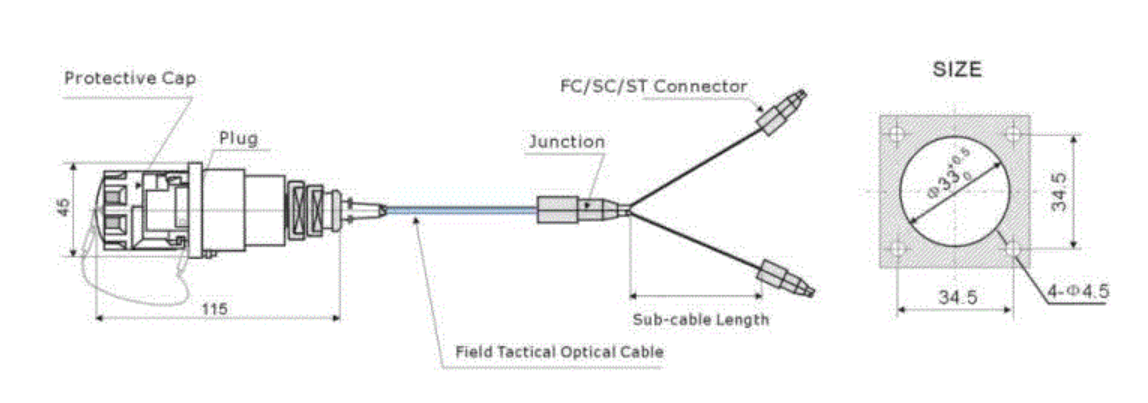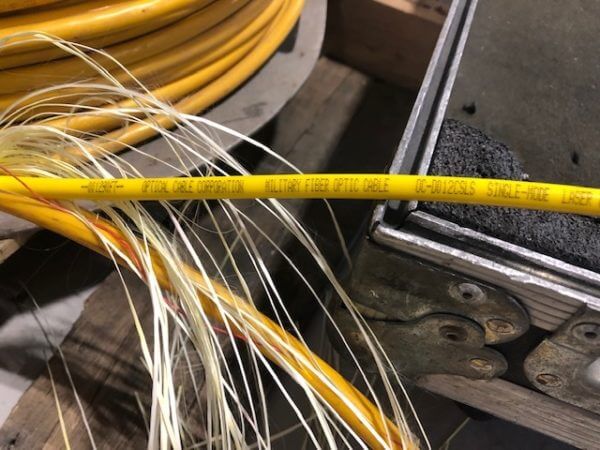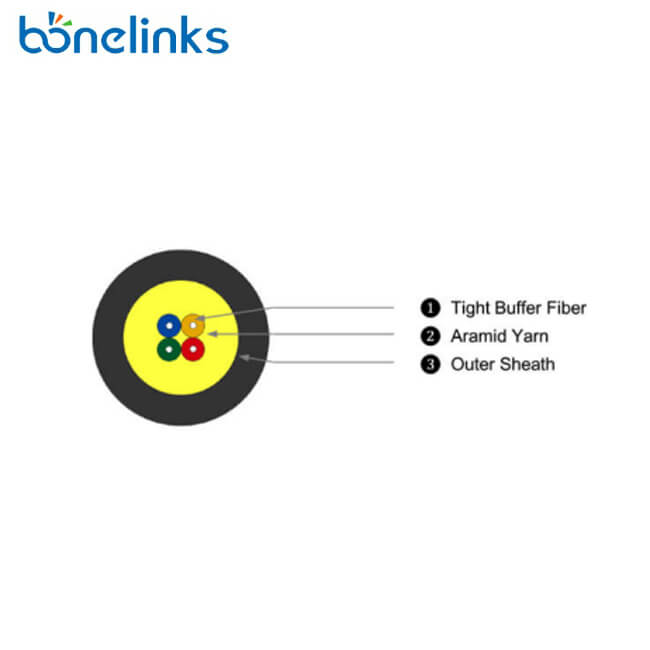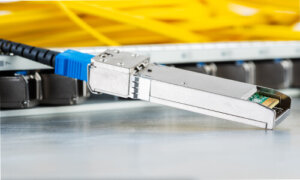Tactical fiber optic cable is designed for military use, outdoor applications, and other situations where harsh environments exist. It has excellent flexibility and high compression resistance. This article can help you learn more about tactical fiber optic cable.
What is Tactical Fiber Optic Cable?
Tactical fiber optic cable is specially designed for military use and harsh environments that require fast routing or repeated retractable and use conditions. It is mainly used for group information transmission between switching nodes in the field integrated communication system, and between switching nodes and user centers, and as a lead device for wireless relay equipment. The transmission line can also be used as a transmission means for occasions where anti-interference and electromagnetic shielding are particularly strict.
It is lightweight, flexible, resistant to tension and compression, and has a high strength/weight ratio. Tactical fiber optic cable is an optical communication trunk line that can be easily retracted in the field. To facilitate rapid deployment, tactical fiber optic cable often comes in the form of tactical fiber optic cable assemblies (TFOCAs).
Tactical Fiber Optic Cable Assembly (TFOCA)
In order to facilitate rapid deployment, tactical fiber optic cables usually appear as fiber optic cable assemblies, including tactical fiber optic cable, TFOCA connectors, and take-up and release racks. For easy portability, the outer diameter of the tactical fiber optic cable is small and the weight is light.

The Development Trend of Tactical Fiber Optic Cable
- Tactical fiber optic cable basically adopts the tight buffer structure to form the optical fiber unit of 0.9-1mm. The reinforcing elements are mainly aramid fibers, and some are accompanied by fiber-reinforced plastic rods. Most sheaths are made of flame-retardant polyurethane, but also neoprene and polyester.
- An optical cable structure is used to accommodate fiber types (such as multi-mode fiber, single-mode fiber, dispersion-shifted single-mode fiber, large-core fiber, etc.), and the fiber is coated to form a fiber unit with a unified appearance, so as to meet different usage requirements.
- There are more and more demands for the use of tactical fiber optic cable in various industries, and the use of anti-nuclear reinforced optical fibers is required to meet the needs of future wars.
Structural Characteristics of Tactical Fiber Optic Cable
Field deployable tactical fiber optic cable is generally composed of high-strength tight-buffered optical fiber, aramid fiber tensile component, metal armor (depending on usage), and flame-retardant polyurethane outer sheath (or PE, PVC, LSZH).
- Tactical fiber optic cable adopts a compact all-dielectric wiring structure, with a 0.9mm tight-buffered optical fiber, which makes the optical cable have a very high strength-to-weight ratio, which is convenient for rapid wiring or repeated retraction.
- The high-strength optical fiber secondary coating of the composite structure, the tactical optical cable provides the best temperature performance and the smallest additional attenuation, ensuring the reliability and service life of the optical cable under harsh conditions.
- Special high-strength, flexible glass fiber reinforced plastic (FRP) center reinforcing component, tactical optical cable ensures the strength and bending performance of the optical cable.
- The large-area aramid reinforced fiber in the tactical optical cable provides extremely high mechanical strength for the optical cable.
- The combination of small-pitch SZ twisted tight-buffered fiber without tie-line and single-helix twisted aramid fiber ensures that the tactical optical cable has a large tensile strain capacity.
- The thermoplastic polyurethane elastomer flame retardant sheath of the tactical optical cable provides the optical cable with good structural stability, compression resistance, abrasion resistance, oil resistance, low-temperature flexibility and flame retardant properties.

Advantages of Tactical Fiber Optic Cable
- Mechanical properties: small size, lightweight, good anti-electromagnetic interference, anti-radio frequency interference and anti-electromagnetic pulse interference performance, no electromagnetic radiation; good flexibility, easy to use; high tensile strength (can withstand pulling in fast wiring), pressure resistance (pressure resistance value reaches 1000N, can withstand truck rolling), wear resistance; can be retracted many times.
- Chemical properties: According to the application environment of the tactical optical cable, the outer sheath can be selected with anti-fuel.
- Environmental performance: The line is quick to set up, has good maneuverability, strong survivability and high tensile strength, and can adapt to wild and complex environments.
- Compared with the civil optical cable, the tactical optical cable has great advantages in tensile load, compression resistance and repeated bending under the same outer diameter.
- It can improve the mobility and reliability of military communications and can adapt to communications under nuclear explosion conditions.
- Good confidentiality, is not easy to be eavesdropped on, which can improve the confidentiality and security of military communications, and is not easy to be damaged by the enemy.
Application of Tactical Fiber Optic Cable
Tactical fiber cable is ideal for where repeated deployment and retrieval for reuse are needed.
- For military wiring: military communications such as radar, aviation and ship wiring
- For field wiring: suitable for fast wiring or repeated retraction and release of field communication systems
- For harsh environments with harsh conditions: coal mines, oil wells, natural gas, ports, geological exploration and other harsh conditions
- Temporary wiring, and may be used for frequent retraction, such as live TV broadcast, emergency repair of communication lines, etc.

Differences between Tactical Fiber Optic Cables and Armored Optical Cables
Both tactical fiber optic cables and armored optical cables can be used in harsh environments. What is the difference between tactical fiber optic cables and armored optical cables?
- In terms of weight, tactical optical cable needs to be relatively light and can be carried by a single person; the armored optical cable will be relatively heavy because mobility does not need to be considered.
- In terms of quality, the communication requirements of tactical optical cables are relatively low, as long as short-distance communication in the field can be achieved; armored optical cables are required to be able to transmit signals over long distances and accurately.
Summary
Tactical fiber optic cable is suitable for outdoor equipment applications. The cable offers unprecedented flexibility combined with high crush resistance, durability and lightweight.
Bonelinks is a tactical fiber optic cable manufacturer, our fiber optic cable consists of single-mode or multi-mode fibers, and can be deployed and retreated quickly. High-strength fatigue-resistant optical fibers are used to ensure the reliability and longevity of tactical optical cables in various harsh operating conditions. Custom tactical fiber cable is available. If you have any needs, please contact us, and we would provide you with the most suitable tactical optical cable solutions.





